 |
||
|
||
| ||
It turned out that the barebone systems examined today come from companies whose models were reviewed before. Moreover, two of three models are very similar to the earlier tested products from Iwill and Soltek, that is why our permanent readers may find useful only examination of the Iwill ZPC. Those who are looking for "the same but with pearl buttons" can turn to the new variations of the old things. Thus, Soltek's new Qbic retains its excellent case but utilizes the Athlon XP which is not welcomed by barebone makers. Iwill XP4-G The Iwill XP4-G is almost identical to the XP4,
except a bit altered face appearance and one peculiarity caused by
the different chipset of the XP4-G mainboard. The current model has a pretty
small (190x270x165 mm) cubic aluminum case with air vents on its sides. The
front panel made of silvery speckled plastic isn't loud but a lot will depend
on a 5" drive.  The functional elements on its face are the same though they changed
their positions (this set of elements is the minimal standard for today):
2 USB (2.0) ports, line-out (for headphones), mic-in, power and Reset buttons.
An external bay is covered with a metallic bracket waiting for you
to replace it with a respective drive. 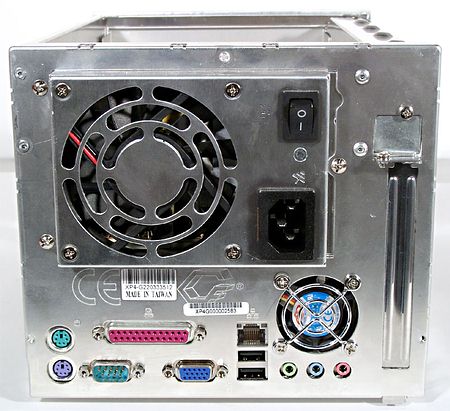 The backside remains entirely the same. Here you can find 2 PS/2,
1 LPT, 1 COM, 1 VGA, 1 LAN, 2 USB (2.0), 3 Audio. Now the big fan blows out
air from the power supply unit (such unit is a very rare thing among barebone
systems), and the small one directly cools the insides. There is also an
output for the only expansion card.  The internal design is very simple: the power supply unit is pressed
to the back panel, and the warm air goes out through vent holes on its sides.
A small Delta fan is also attached to the back panel. The CD/DVD and hard
drives (there are only two bays - 5" and 3" ones) are attached right to the
mounts. It's really convenient because no racks are needed and the IDE cable
placed among them lets avoid the problem of how to arrange the cables inside.
But if the floppy drive is installed before the hard drive, you will have
to demount the former to put the HDD inside. Unfortunately, the case can't
house two internal bays but I wish this one should be a little higher so
that the hard drive wouldn't pressed so tightly to the upper device.  The mianboard used in the Iwill XP4-G is based on the i845GE
chipset. Beside the higher speed there appears one more difference
between two Iwill's models which makes them supplemental rather than competing.
As compared to the i845GV, the i845GE supports external AGP cards, that
is why the only expansion slot in the XP4 is of the PCI standard, and the
XP4-G has an AGP one (4x, only 1.5V cards). The board also supports processors
with the FSB up to 533 MHz, DDR200/266/333 (only one slot!), 6 USB 2.0 ports
(but there is place only for 4 of them), 6-channel ALC650 AC'97 codec and
network Realtek 8100B PHY controller. In the scarce and very inconvenient
WhizPro BIOS you can adjust memory timings and select its frequency, manually
assign IRQs, change the FSB clock up to 250 MHz in 1MHz steps with flexible
regulation of AGP/PCI bus frequencies.  As to the fans, we couldn't figure it out how we could set the threshold
for the two rear fans to start up. Moreover, a temperature sensor on the
mainboard is lacking or doesn't work. However, when we mounted the
standard test cooler CoolerMaster
CI4-7I53A (there is no CPU cooler supplied) the temperature of
the monitored components didn't exceed the extreme values. As you can see, even the Intel Pentium 4 3.06 GHz, the most efficient
and hottest processor among supported models, paired with one of the hottest
video cards based on the GeForce4 Ti 4600 didn't let down the cooler on the
Iwill XP4-G. Here are the brief characteristics of this barebone system that ships in a usual cardboard box with a handle.
Iwill ZPC If you look at this model and its specs you will see that the Iwill
ZPC belongs to a special class of miniature devices. If other barebone systems
are actually just small copies of desktop models, the ZPC, like the EZgo MiniPC,
is a conceptual model. Here a lot is offered in sacrifice, and the
price grows up in proportion to deviation from the standards. What for such
computer is needed will be discussed after its full examination. Just note
that judging by its dimensions (184x263x54 mm) it's comparable to an ordinary
internal CD/DVD drive.   It's encompassed into a tiny aluminum case with two figured plexiglas
plates above and below. The case can stand upright. The latter is recommended
in the manual, but on the photo you can see how stable the Iwill ZPC is,
that is why you shouldn't place it on desktop. The miniature dimensions put
forward the cooling issue. The air hole is only one (with a decorative air
vent). Besides, there is only one output on the backside. There are no air
vents on its sides probably to protect the mounting surface from hot air.
The weight of this model is 4 kg at most.  The front panel houses 2 FireWire, 2 USB (2.0) ports, line-out
and a mic-in, power and Reset buttons and a slim CD/DVD drive bay. Originally
Iwill planned on a big choice of color combinations of the frontal surface
and case, but then decided on only two versions: a black case with a slit-type
drive (which is tested) and a silvery one designed for a drive with an in-out
tray. 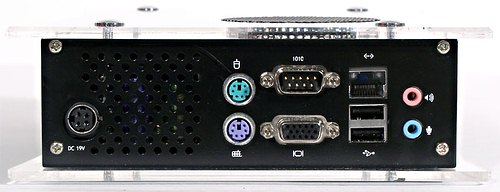 On the back are 2 PS/2, 1 COM (no second serial and parallel ports),
1 VGA, 1 LAN, 2 USB (2.0) and 2 audio connectors that double the front ones
(only one input/output of the doublers works at a time). A round connector
on the left indicates that the ZPC uses an external power supply unit (from
Delta Electronics, 19V, 90W). The rear panel is attached with 4 screws;
when it's unscrewed the contents can be drawn out as a single whole.
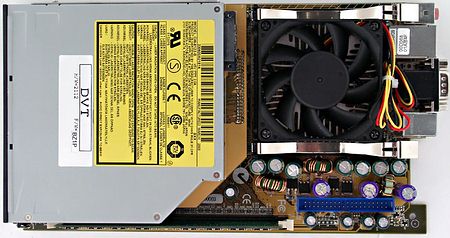 The heart of the computer is a mainboard with an affixed special
daughter card with disc storage units. At first glance the insides are carefully
designed, the only cable inside is used to connect the cooler!  All the connectors and buttons in front and behind are soldered
out on the board (therefore it should be handled very carefully). 4 connectors
looking like IDE ones are used to connect internal devices. The mainboard
is built on the i845GV chipset (an analog of the i845G without an external AGP
port), supports FSB up to 533 MHz and memory up to 266 MHz (only one module).
The photos of the connectors perfectly show
what peripherals can be supported. No expansion cards are certainly supported.  The computer is designed for one 2.5" hard drive (of the notebook
PC type) and one slim-type CD/DVD drive. The drive is not supplied with the
computer, but you can order it separately and it will match the front cover
in color. The installation procedure is unusual: first you must press
the hard drive to the special daughter card, move it over its interface connector
and then fasten its backside with screws. The floppy drive installs the same
way, only on the reserve side of the card. Then you must attach the daughter
card to the mainboard, with all three connectors going into three "IDE connectors"
on the board (the connectors are shown on the photo next to the hard drive).
Since the hard drive is placed not higher than the plugs on the daughter
card, the connection looks like a bridge, and the hard drive hangs over the
chipset heatsink (affecting its thermal conditions).  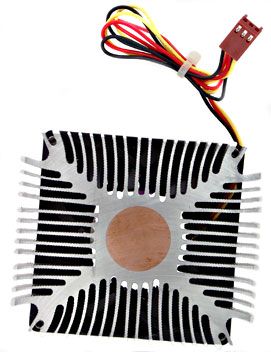 The cooler comes from a noname company with a 70mm fan from Bi-Sonic.
The aluminum heatsink 12 mm high is designed in the form of ramifying
branches with a copper core in the middle. There are two clips that fasten
it to the board. The fan draws the air taken from outside onto the sink,
and its rotation speed makes only 2800-3000 rpm which (together with noiseless
notebook-type disc storage units) maintains noise at a low level. This is
the quietest barebone system among the tested models equipped with fans.
The cooler is pretty effective. But we tested it with the Pentium
4 1.8 GHz because it arrived in our lab with this processor, while the maximum
permitted CPU is Pentium 4 2.53 GHz (however, it reached 45°C under load).
Besides, we couldn't monitor the hard drive's temperature, but the threshold
of 50°C looks like to be exceeded. It's quite possible that the potential
overheating of other components inside the case made the developers limit
the maximum CPU clock (the cooler might cope with a 3GHz model).  Finally have a look at the photo of the voltage changer card that is inserted into the last fourth "IDE connector" on the mainboard behind. In the BIOS (I hope no one would undertake overclocking) you can change memory timings and its frequency, manually assign IRQs, change the FSB clock up to 166 MHz in 1MHz steps with correct regulation of AGP/PCI bus frequencies. Here are the brief characteristics of this barebone system.
Soltek Qbic EQ3701M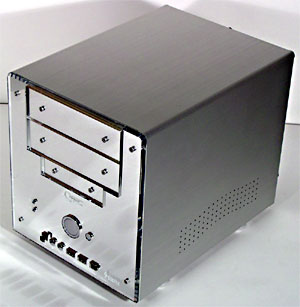  The EQ3701M is encompassed into the same aluminum case (Shuttle
G2) with a mirror cover on the face, like that on the EQ3000M.
But since the mainboards used in these systems are different, the
layout of connectors in front and behind is also different. The EQ3000M
is not an entirely Soltek's solution since the case is made by Shuttle and
reminds its XPC. However, we do not reproach it because usage of other's
but successful idea is preferable for end-users. 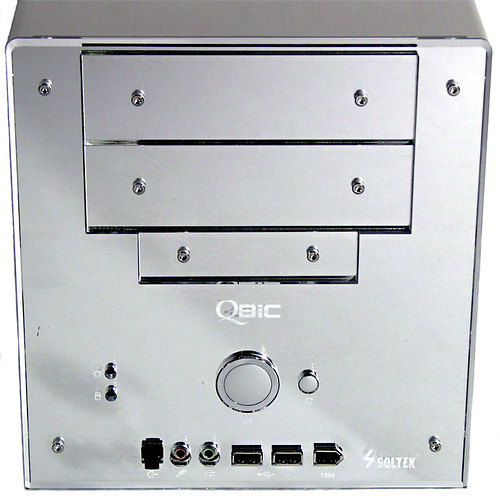 The silvery power and reset buttons and black speckles of the ports
match well the mirror surface. On the other hand, this mirror-like cover
is made of plastic, that is why scratches and fingerprints are inevitable.
Another problem is that the front panel will lose its attractive look with
the installation of 3" and 5" drives. So, keep in mind that the EQ3701M will
look less effective in the real life. Also note that this model of
the Qbic series doesn't have a twin with a mat-white surface (indexed W),
but it's possible that in future such variant will be also available. The
collection of connectors is not outstanding, but there is everything you
may need, and all connectors except S/PDIF-Out double on the backside (it
lets you choose the place of connection). So, in front it has S/PDIF-out,
2 standard audio connectors, 2 USB (2.0) and 1 FireWire. Two external
5" bays distinguish Soltek's Qbic EQ3xxx models among all barebone systems
on the market. The EQ3000 has a twin with a single 5.25" bay, but the today's
hero has only one variation. 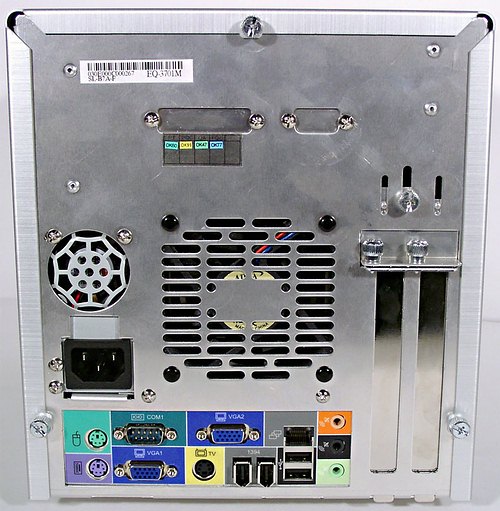 The backside has a traditional design for Shuttle/Soltek barebone
computers. It can differ only in connectors. Here we can see PS/2 keyboard
and mouse ports, 1 COM, 2 analog monitor outputs, S-Video output, 2
FireWire, 2 USB (2.0), mains and 3 standard audio connectors. The mainboard
also has LPT and second COM ports, but you have to find the cables for them
yourselves (they can be placed either on a standard panel placed instead
of an expansion card or inserted into holes on the backside). Finally, the
Soltek EQ3701M has a power supply connector, a small fan on the power supply
unit, a big fan and two slits for expansion cards. 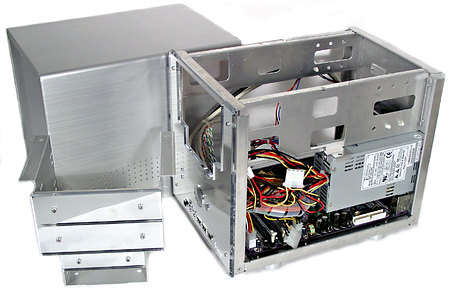 The arrangement of the components is identical to any Shuttle's
barebone PC, and entirely coincides with the EQ3000M. The installation is
very simple: you don't have to screw or unscrew anything. It's just desirable
that you put the drives into the rack when it's out of the case (there are
only two screws). 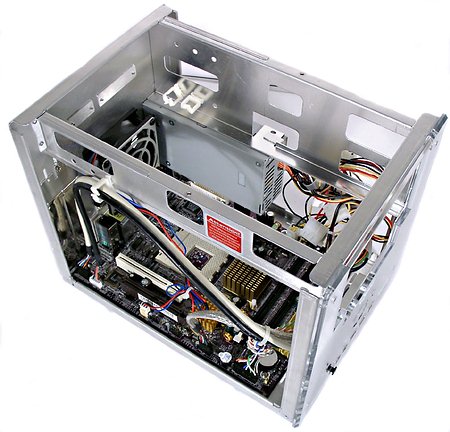 For better ventilation all standard cables should be stretched along
the panels which have special plastic clips for them. Two ATA66 and one FDD
cables are cut into stripes and tightened into one thin bundle. 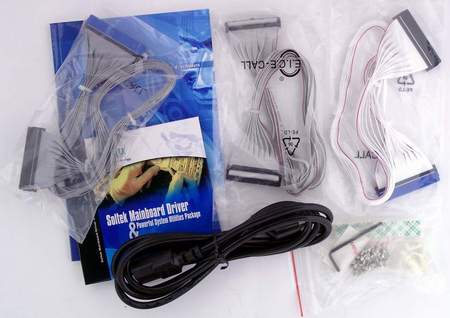 It was strange to find ATA cables with two connectors each (one
cable is designed for only one device) - Soltek stubbornly keeps to such
a strange policy of completing its PCs, which have 2 5" bays as a distinguishable
factor (2 optical drives + 1 hard drive = 3 devices). Of course, you can
buy a narrow cable separately or make it out of a usual wide one, but owners
of expensive systems have the right to count on something more.  The cooling system consists of a CPU cooler supplied and a quality
80mm fan from ADDA with temperature control support for the backside. (Note
that Shuttle models come with coolers based on the I.C.E. heat-pipe technology
where the CPU cooler and the fan on the backside make a single whole.) We
couldn't find out who made the CPU cooler and we can't give you its specs,
but it has an all-copper heatsink, a well polished base, and 6 fastening
teeth (a screwdriver needed). The cooling effectiveness is very high. The hard drive's and system's temperature remains acceptable even
with the hot GeForce4 Ti 4600 based card and at the maximum CPU load. The
CPU's temperature looks dangerous because the maximum allowable Barton's
temperature of 85°C was almost reached (the BIOS turns off the system when
an assigned temperature threshold is reached). Why do we consider such cooler
system sufficient? The BIOS offers three modes of operation of the CPU's
fan which differ in the speed of rotation. We set the quietest mode with
the frequency of 2400-2500 rpm in the standby mode and up to 2900
rpm under load (by the way, the other fan inside the PC case rotated at 1800
to 2200 rpm and it was very quiet). Besides, we used the processor with the
highest heat generation degree among all processors supported by the EQ3701M
board. That is why, the cooling system has a solid reserve in case of high
air temperature or other potential problems.  Like all other barebone makers Soltek uses its own mainboards,
and in this case it is Soltek B7A-F based on the NVIDIA
nForce2-GT chipset. The board supports FSB clock up to 333 MHz
(up to Barton 3000+ inclusive), up to 2 GB DDR200/266/333/400 (2 DIMM
slots only), external AGP 8x video accelerators, 6 USB 2.0 ports,
3 FireWire ports, 10/100 Mbit Ethernet and 6-channel sound (at the expense
of the APU included into the south bridge with the Dolby Digital support
and with Realtek ALC650 AC'97 codec). Besides, the integrated video accelerator
simultaneously supports two analog monitor-outs (nView technology) or a TV-out
(S-Video) instead one of them, and demonstrates more or less good performance
in games (the details are a bit later). One AGP and one PCI slots for full-sized
cards are standard for barebone computers from Shuttle and Soltek. But the
overclocking features of the EQ3701M are not standard: you can change the
FSB clock up to 250 MHz in 1MHz steps, CPU, chipset and AGP voltage (up to
1.85, 1.8, 1.8 and 2.8 V respectively), CPU clock ratio up to x22, memory
timings, memory clock and PCI/AGP clock in a wide range. The chipset's rich
potential is thus entirely realized. Here are the brief characteristics of this barebone system that ships in a beautiful cardboard box with a handle.
PerformanceTestbed:
Software:
The performance tests are actually useless, because if you want to estimate their speed you should check it up in the reviews of these chipsets. Boards based on the same chipset but produced by different companies can have different speed, but the gap can be 2-3% at most. Moreover, the scores of each contestant will be shown on a separate diagram to that no one could reproach us of speed comparison. We are going to use the tests where we can estimate the performance drop caused by the integrated video core (it's just interesting to figure out to what degree the processor simply heats up air). Also, we will thoroughly test them in 3D games where an integrated core doesn't always have an alternative, and absolute figures are very important because they answer the question: can I play or not? Finally we will test each model separately in a great deal of benchmarks
in order to reveal possible artifacts in performance and check the overall
operability with all integrated controllers enabled. The Soltek has brilliant scores (the dual-channel memory controller
of the nForce2 looks like to be specially created to demonstrate
superiority of the chipset in such tests). The Iwill XP4-G has more modest
scores by 4-10%. (This test turns to be useless for the Iwill ZPC because
its integrated video core doesn't have an alternative.) The speed in games is not a strong point of the i845GE: without
an external video card the Iwill XP4-G can be used only for a slide-show
in gaming resolutions even with the most powerful supported processor. However,
you can even run at 800x600. The i845GV is slow as well, and a faster processor wouldn't help
it either. Taking into account that the video system of the Iwill ZPC can't
be improved, this barebone PC leaves the rows of contenders. The Soltek EQ3701M guarantees over 50 fps in 1024x768x32 in the games (though it was coupled with the fastest processor and used the dual-channel memory mode). Anyway, you can make this computer playable even without an external card. ConclusionThe Iwill XP4 and the Soltek EQ3701M are good computers that pleasantly extend the row of products of their companies. The Iwill ZPC could be recommended as a replacement for an average office PC thanks to its small dimensions and attractive appearance... if it were not its price (around $300 at the time of writing this article on our local market; it's $100 over the price of more functional models of the XP4 series of the same company). Can it be used as a multimedia center?.. The ZPC has neither TV-out nor outputs for 6-channel sound (only stereo). Also, it lacks for 3D performance to be a good home system. Besides, a DVI-out is not exotic today. Thus, this expensive product repeats the positioning of another ultra-small PC: this is an image model for those who value appearance and quietness most of all. In closing, here is a brief list of the most typical strong and weak points of each barebone system. Iwill XP4-GHighs:
Lows:
Iwill ZPCHighs:
Lows:
Soltek Qbic EQ3701MHighs:
Lows:
Write a comment below. No registration needed!
|
Platform · Video · Multimedia · Mobile · Other || About us & Privacy policy · Twitter · Facebook Copyright © Byrds Research & Publishing, Ltd., 1997–2011. All rights reserved. |